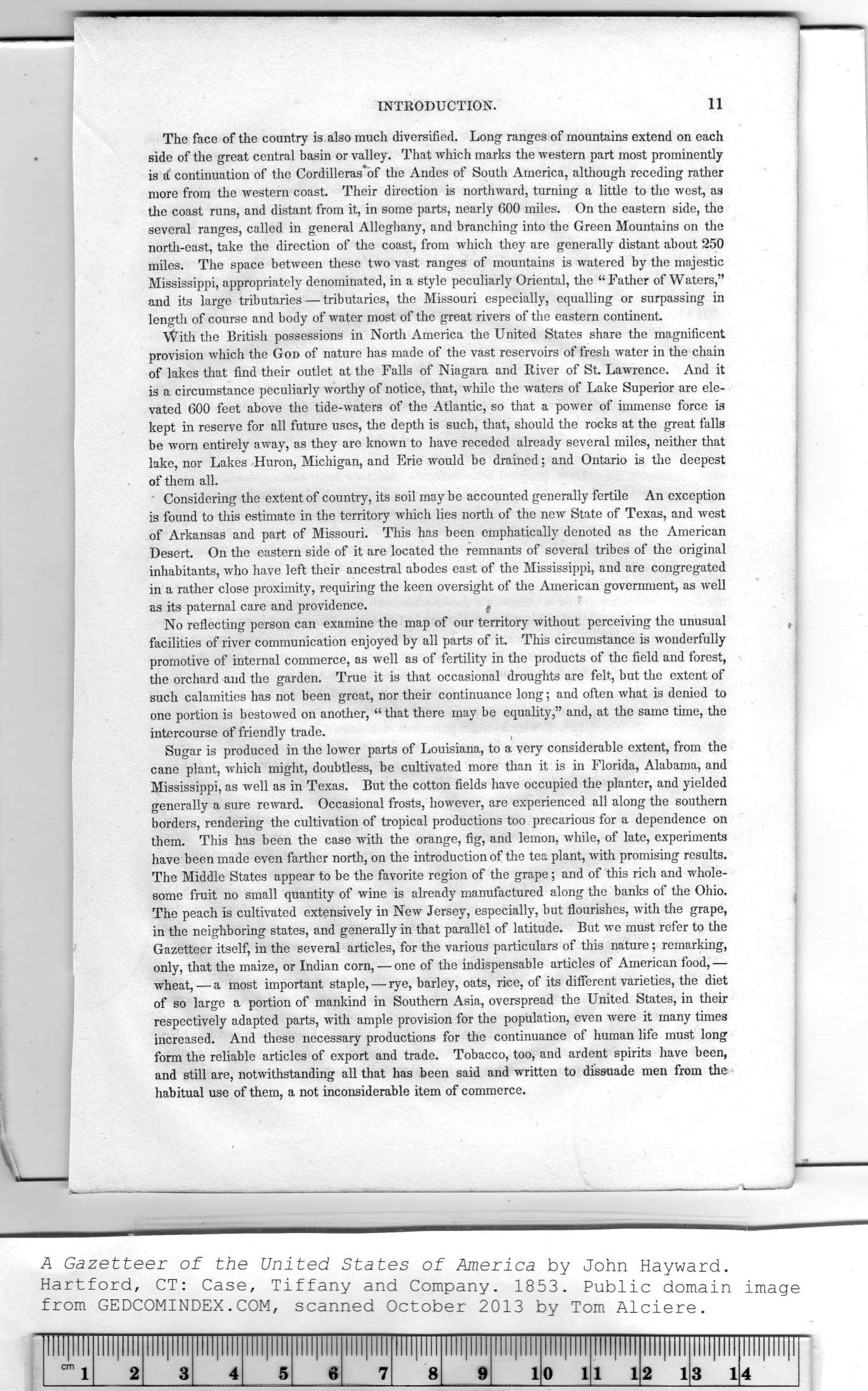|
|
Note: Ctrl and + increases the font size of the text below, Ctrl and - decreases it, and Ctrl and 0 resets it to default size.
INTRODU CTION. 11
The face of the country is . also much diversified. Long ranges of mountains extend on each
side of the great central basin or valley. That which marks the western part most prominently
is a continuation of the Cordilleras of the Andes of South America, although receding rather
more from the western coast. Their direction is northward, turning a little to the west, as
the coast runs, and distant from it, in some parts, nearly 600 miles. On the eastern side, the
several ranges, called in general Alleghany, and branching into the Green Mountains on the
north-east, take the direction of the coast, from which they are generally distant about 250
miles. The space between these two vast ranges of mountains is watered by the majestic
Mississippi, appropriately denominated, in a style peculiarly Oriental, the “Father of Waters,"
and its large tributaries — tributaries, the Missouri especially, equalling or surpassing in
length of course and body of water most of the great rivers of the eastern continent.
With the British possessions in North America the United States share the magnificent
provision which the God of nature has made of the vast reservoirs of fresh water in the chain
of lakes that find their outlet at the Falls of Niagara and River of St. Lawrence. And it
is a circumstance peculiarly worthy of notice, that, while the waters of Lake Superior are ele-
vated 600 feet above the tide-waters of the Atlantic, so that a power of immense force is
kept in reserve for all future uses, the depth is such, that, should the rocks at the great falls
be worn entirely away, as they are known to have receded already several miles, neither that
lake, nor Lakes Huron, Michigan, and Erie would be drained; and Ontario is the deepest
of them all.
Considering the extent of country, its soil may be accounted generally fertile An exception
is found to this estimate in the territory which lies north of the new State of Texas, and west
of Arkansas and part of Missouri. This has been emphatically denoted as the American
Desert. On the eastern side of it are located the remnants of several tribes of the original
inhabitants, who have left their ancestral abodes east of the Mississippi, and are congregated
in a rather close proximity, requiring the keen oversight of the American government, as well
as its paternal care and providence.
No reflecting person can examine the map of our territory without perceiving the unusual
facilities of river communication enjoyed by all parts of it. This circumstance is wonderfully
promotive of internal commerce, as well as of fertility in the products of the field and forest,
the orchard and the garden. True it is that occasional droughts are felt, but the extent of
such calamities has not been great, nor their continuance long; and often what is denied to
one portion is bestowed on another, “ that there may be equality," and, at the same time, the
intercourse of friendly trade.
Sugar is produced in the lower parts of Louisiana, to a very considerable extent, from the
cane plant, which might, doubtless, be cultivated more than it is in Florida, Alabama, and
Mississippi, as well as in Texas. But the cotton fields have occupied the planter, and yielded
generally a sure reward. Occasional frosts, however, are experienced all along the southern
borders, rendering the cultivation of tropical productions too precarious for a dependence on
them. This has been the case with the orange, fig, and lemon, while, of late, experiments
have been made even farther north, on the introduction of the tea plant, with promising results.
The Middle States appear to be the favorite region of the grape; and of this rich and whole-
some fruit no small quantity of wine is already manufactured along the banks of the Ohio.
The peach is cultivated extensively in New Jersey, especially, but flourishes, with the grape,
in the neighboring states, and generally in that parallel of latitude. But we must refer to the
Gazetteer itself, in the several articles, for the various particulars of this nature; remarking,
only, that the maize, or Indian corn, — one of the indispensable articles of American food, —
wheat, — a most important staple, — rye, barley, oats, rice, of its different varieties, the diet
of so large a portion of mankind in Southern Asia, overspread the United States, in their
respectively adapted parts, with ample provision for the population, even were it many times
increased. And these necessary productions for the continuance of human life must long
form the reliable articles of export and trade. Tobacco, too, and ardent spirits have been,
and still are, notwithstanding all that has been said and written to dissuade men from the
habitual use of them, a not inconsiderable item of commerce.
|
